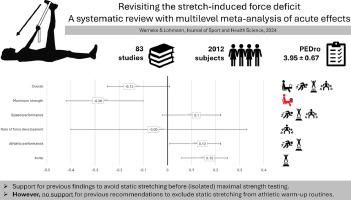当前位置:
X-MOL 学术
›
J. Sport Health Sci.
›
论文详情
Our official English website, www.x-mol.net, welcomes your
feedback! (Note: you will need to create a separate account there.)
Revisiting the stretch-induced force deficit: A systematic review with multilevel meta-analysis of acute effects
Journal of Sport and Health Science ( IF 9.7 ) Pub Date : 2024-05-10 , DOI: 10.1016/j.jshs.2024.05.002 Konstantin Warneke 1 , Lars Hubertus Lohmann 2
Journal of Sport and Health Science ( IF 9.7 ) Pub Date : 2024-05-10 , DOI: 10.1016/j.jshs.2024.05.002 Konstantin Warneke 1 , Lars Hubertus Lohmann 2
Affiliation

|
When recommending avoidance of static stretching athletic performance, authors and practitioners commonly refer to available systematic reviews. However, effect sizes (ES) in previous reviews were extracted in major part from studies lacking control conditions and/or pre–post testing designs. Also, currently available reviews conducted calculations without accounting for multiple study outcomes, with ES: –0.03 to 0.10, which would commonly be classified as trivial. Since new meta-analytical software and controlled research articles have appeared since 2013, we revisited the available literatures and performed a multilevel meta-analysis using robust variance estimation of controlled pre–post trials to provide updated evidence. Furthermore, previous research described reduced electromyography activity—also attributable to fatiguing training routines—as being responsible for decreased subsequent performance. The second part of this study opposed stretching and alternative interventions sufficient to induce general fatigue to examine whether static stretching induces higher performance losses compared to other exercise routines. Including 83 studies with more than 400 ES from 2012 participants, our results indicate a significant, small ES for a static stretch-induced maximal strength loss (ES = –0.21, = 0.003), with high magnitude ES (ES = –0.84, = 0.004) for stretching durations ≥60 s per bout when compared to passive controls. When opposed to active controls, the maximal strength loss ranges between ES: –0.17 to –0.28, < 0.001 and 0.040 with mostly no to small heterogeneity. However, stretching did not negatively influence athletic performance in general (when compared to both passive and active controls); in fact, a positive effect on subsequent jumping performance (ES = 0.15, = 0.006) was found in adults. Regarding strength testing of isolated muscles (e.g., leg extensions or calf raises), our results confirm previous findings. Nevertheless, since no (or even positive) effects could be found for athletic performance, our results do not support previous recommendations to exclude static stretching from warm-up routines prior to, for example, jumping or sprinting.
中文翻译:

重新审视拉伸引起的力不足:急性影响多层次荟萃分析的系统评价
在建议避免静态拉伸运动表现时,作者和从业者通常会参考可用的系统评价。然而,以往综述中的效应量 (ES) 主要来自缺乏控制条件和/或前后测试设计的研究。此外,目前可用的综述在进行计算时没有考虑多个研究结果,ES:-0.03 至 0.10,这通常被归类为琐碎。由于自 2013 年以来出现了新的荟萃分析软件和对照研究文章,我们重新审视了现有文献,并使用对照前后试验的稳健方差估计进行了多层次荟萃分析,以提供更新的证据。此外,以前的研究描述了肌电图活动减少——也归因于疲劳的训练程序——是导致后续表现下降的原因。本研究的第二部分反对拉伸和足以引起全身疲劳的替代干预措施,以检查与其他锻炼程序相比,静态拉伸是否会导致更高的性能损失。包括 83 项研究,来自 400 名参与者的 2012 多个 ES,我们的结果表明静态拉伸诱导的最大力量损失 (ES = –0.21, = 0.003) 显着的小 ES,与被动对照组相比,拉伸持续时间 ≥ 60 秒/次。与主动对照相反,最大强度损失在 ES 之间:–0.17 至 –0.28,< 0.001 和 0.040,大多数没有或很小的异质性。 然而,伸展运动总体上不会对运动表现产生负面影响(与被动和主动对照相比);事实上,在成人中发现对随后的跳跃表现有积极影响 (ES = 0.15, = 0.006)。关于孤立肌肉的力量测试(例如,腿部伸展或小腿抬高),我们的结果证实了以前的发现。然而,由于没有发现对运动表现有(甚至积极)影响,我们的结果不支持之前的建议,即在跳跃或短跑等热身程序中排除静态拉伸。
更新日期:2024-05-10
中文翻译:

重新审视拉伸引起的力不足:急性影响多层次荟萃分析的系统评价
在建议避免静态拉伸运动表现时,作者和从业者通常会参考可用的系统评价。然而,以往综述中的效应量 (ES) 主要来自缺乏控制条件和/或前后测试设计的研究。此外,目前可用的综述在进行计算时没有考虑多个研究结果,ES:-0.03 至 0.10,这通常被归类为琐碎。由于自 2013 年以来出现了新的荟萃分析软件和对照研究文章,我们重新审视了现有文献,并使用对照前后试验的稳健方差估计进行了多层次荟萃分析,以提供更新的证据。此外,以前的研究描述了肌电图活动减少——也归因于疲劳的训练程序——是导致后续表现下降的原因。本研究的第二部分反对拉伸和足以引起全身疲劳的替代干预措施,以检查与其他锻炼程序相比,静态拉伸是否会导致更高的性能损失。包括 83 项研究,来自 400 名参与者的 2012 多个 ES,我们的结果表明静态拉伸诱导的最大力量损失 (ES = –0.21, = 0.003) 显着的小 ES,与被动对照组相比,拉伸持续时间 ≥ 60 秒/次。与主动对照相反,最大强度损失在 ES 之间:–0.17 至 –0.28,< 0.001 和 0.040,大多数没有或很小的异质性。 然而,伸展运动总体上不会对运动表现产生负面影响(与被动和主动对照相比);事实上,在成人中发现对随后的跳跃表现有积极影响 (ES = 0.15, = 0.006)。关于孤立肌肉的力量测试(例如,腿部伸展或小腿抬高),我们的结果证实了以前的发现。然而,由于没有发现对运动表现有(甚至积极)影响,我们的结果不支持之前的建议,即在跳跃或短跑等热身程序中排除静态拉伸。


















































 京公网安备 11010802027423号
京公网安备 11010802027423号